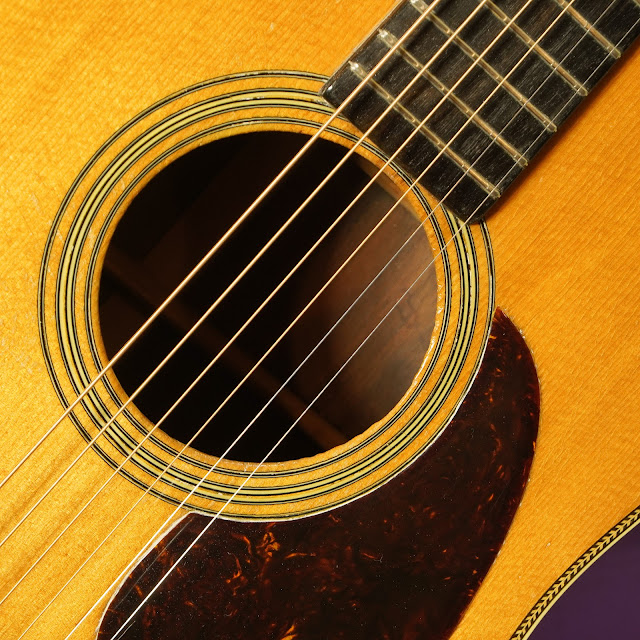1937/1950s Martin D-28 Dreadnought Guitar
This guitar is quite the oddity. At its heart is a 1937 Martin D-28 -- complete with that gorgeous, jaw-dropping Brazilian rosewood for the back and sides, yes. To this has been added a 1950s Martin top (it looks like a Martin factory job from the time, judging by the cut of the braces inside) and a fresh headstock veneer for the back of the headstock and either refinishing or overspray all around. I'm surprised, in many ways, that the replacement top still has herringbone trim, though. Fancy!
When this arrived, it had some issues -- brace separation just behind the bridge on the main x-braces, heavy Grover Rotomatic tuners in gold at the headstock, and a sound that was definitely a "good '50s sound" but wasn't as close to the '30s sound as the owner would like. I was going to initially replace the ebony bridge that's on it, too, but after taking a look underneath (and finding four hidden bolts with odd build-up around them) I decided to leave that for another day.
I solved the structural stuff and then, per the owner's request, set-about shaving the braces to get some more oomph out of them. The problem with this on '50s bracing, though, is that '50s bracing is sort-of thin and tall and straight. It doesn't come to the same height "peaks" as scalloped bracing, so you can't just scallop the braces in the same manner to improve the tone. You have to be a lot more careful about how much you take out in the middle.
I gently scalloped the main x-braces on the lower bout with my mini-planes (through the soundhole) and then attacked the tonebars a lot more vigorously. This boosts low-end response and gives it a "quicker" tone without becoming muddy as it would if you heavily-scalloped braces that were straight to begin-with. If you heavily-scallop braces that don't get as high as properly-scalloped original braces, you wind-up with a sort-of unstable, woofy sound. I'm really pleased with the way this one has turned-out -- it has a really good set of mids and a clean sound that booms-out with piano-like oomph on the low notes. I angled the mic a little poorly in the video, though, so you don't hear the boom of the lows as much as it actually has. It has a ton of sustain, too.
Repairs included: brace repairs, brace shaving, a fret level/dress, newer Grover Waverly-style tuner install, new bone saddle, nut adjustments/spacing fixes, and setup.
Top wood: solid spruce ('50s replacement)
Back & sides wood: solid Brazilian rosewood
Bracing type: x (straight, very lightly added scallop)
Bridge: ebony (replacement)
Fretboard: ebony
Neck wood: mahogany
Action height at 12th fret: 3/32” bass 1/16” treble (fast, spot-on)
String gauges: 54w-12 lights
Neck shape: medium-big C/V
Board radius: ~14"
Truss rod: non-adjustable
Neck relief: straight
Fret style: medium-low
Scale length: 25 3/8"
Nut width: 1 3/4"
Body width: 15 5/8"
Body depth: 4 7/8"
Weight: 4 lbs 13 oz
Condition notes: please read the description above for all of the extensive modifications... there's a lot to list... but suffice to say the whole thing looks grand.




















Comments